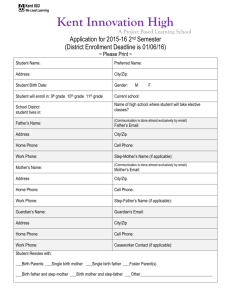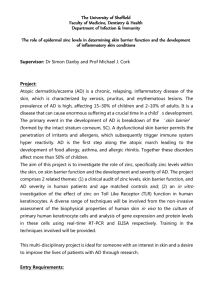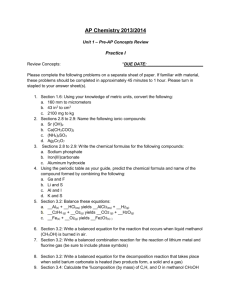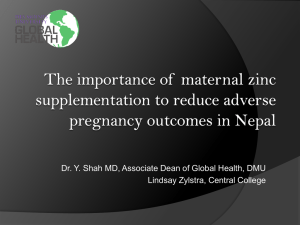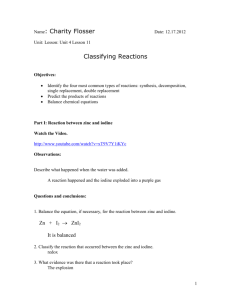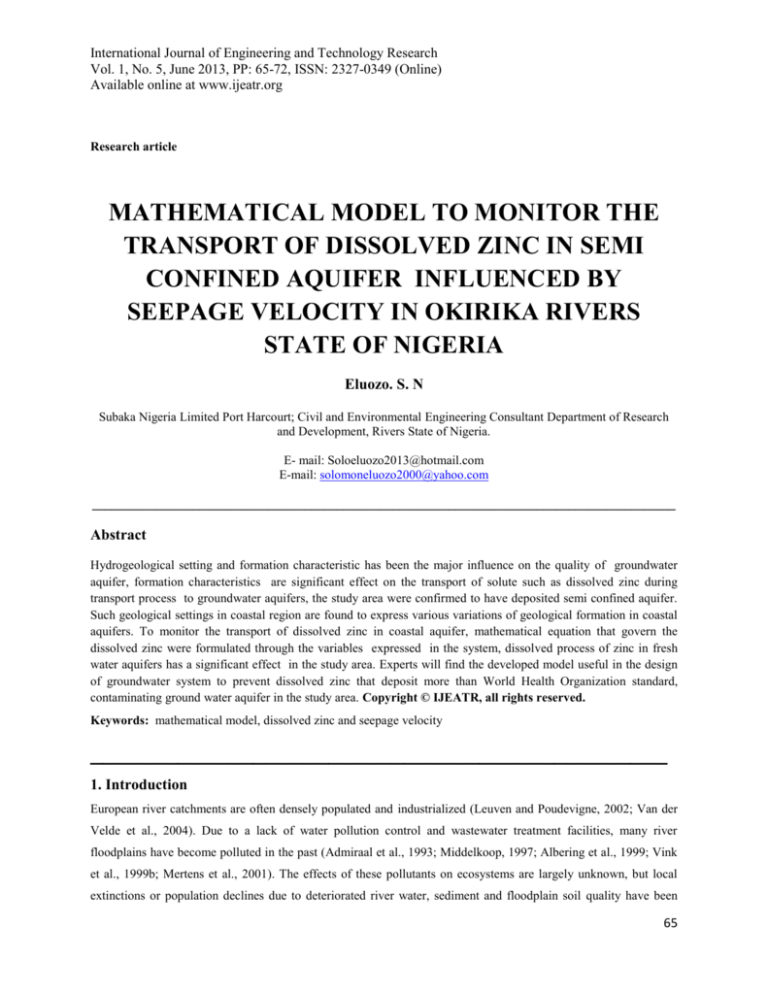
International Journal of Engineering and Technology Research
Vol. 1, No. 5, June 2013, PP: 65-72, ISSN: 2327-0349 (Online)
Available online at www.ijeatr.org
Research article
MATHEMATICAL MODEL TO MONITOR THE
TRANSPORT OF DISSOLVED ZINC IN SEMI
CONFINED AQUIFER INFLUENCED BY
SEEPAGE VELOCITY IN OKIRIKA RIVERS
STATE OF NIGERIA
Eluozo. S. N
Subaka Nigeria Limited Port Harcourt; Civil and Environmental Engineering Consultant Department of Research
and Development, Rivers State of Nigeria.
E- mail: Soloeluozo2013@hotmail.com
E-mail: solomoneluozo2000@yahoo.com
_____________________________________________________________________________________________
Abstract
Hydrogeological setting and formation characteristic has been the major influence on the quality of groundwater
aquifer, formation characteristics are significant effect on the transport of solute such as dissolved zinc during
transport process to groundwater aquifers, the study area were confirmed to have deposited semi confined aquifer.
Such geological settings in coastal region are found to express various variations of geological formation in coastal
aquifers. To monitor the transport of dissolved zinc in coastal aquifer, mathematical equation that govern the
dissolved zinc were formulated through the variables expressed in the system, dissolved process of zinc in fresh
water aquifers has a significant effect in the study area. Experts will find the developed model useful in the design
of groundwater system to prevent dissolved zinc that deposit more than World Health Organization standard,
contaminating ground water aquifer in the study area. Copyright © IJEATR, all rights reserved.
Keywords: mathematical model, dissolved zinc and seepage velocity
______________________________________________
1. Introduction
European river catchments are often densely populated and industrialized (Leuven and Poudevigne, 2002; Van der
Velde et al., 2004). Due to a lack of water pollution control and wastewater treatment facilities, many river
floodplains have become polluted in the past (Admiraal et al., 1993; Middelkoop, 1997; Albering et al., 1999; Vink
et al., 1999b; Mertens et al., 2001). The effects of these pollutants on ecosystems are largely unknown, but local
extinctions or population declines due to deteriorated river water, sediment and floodplain soil quality have been
65
International Journal of Engineering and Technology Research
Vol. 1, No. 5, June 2013, PP: 65-72, ISSN: 2327-0349 (Online)
Available online at www.ijeatr.org
suggested in several studies (Balk et al., 1993; Kerkhofs et al., 1993; Hendriks et al., 1995; Kooistra et al., 2001).
Deposited pollutants are subject to hydromorphodynamics (e.g. flooding, erosion and sedimentation processes) and
turbation by animals. However, knowledge on the fate of heavy metals, especially in relation to turbation and
inundation, is scarce of Floodplain soils often abundantly harbour burrowing animals, so-called bioturbators,
including various mammals (e.g. voles, mice and moles) and soil macro-invertebrates, like earthworms and insects
and their larvae (Mitchell, 1988; Mu¨ller-Lemans, 1996; Tyler et al., 2001). Bioturbation processes include digging,
casting, and construction of nests and burrows. Bioturbation occurs especially in the upper 20 cm of soils, where the
most recently deposited pollutants are present (Middelkoop, 1997). Some species like epigeic earthworms (e.g.
Lumbricus rubellus) are especially active in the upper 3 cm of topsoil (Zorn, 2004), and all species burrowing
deeper but frequently surfacing (e.g. endogeic and anecic earthworm species and underground dwelling small
mammal species) or species burrowing from the surface to deeper layers (e.g. rabbits and voles searching for food)
turbate the topsoil as well. Zinc is a widespread heavy metal in river systems, occurring in elevated and potentially
toxic quantities all over Europe (Balk et al., 1993; Kalbitz and Wennrich, 1998).
Zinc is essential for life in all organisms but is toxic in excess, which requires homeostatic mechanisms to control
intracellular zinc levels. E\ux of zinc in Escherichia coli is accomplished by the P-type ATPase ZntA and the cation
di!usion facilitator (CDF) ZitB The CDF family Grass et 2001,Njes and Silven, 1996 stated that of proteins has
common structural characteristics, with (in most cases) six transmembrane helices and N- and C-terminal histidinerich motifs predicted to extend into the cytosol. These membrane transporters are usually involved in zinc transport
across cytoplasmic or organelle membranes [3^6]. Some prokaryotic CDF proteins also transport cobalt and
cadmium [7^10]. Recently, Gu!anti et al 2002. Rosen el at 1978, Padan and Schaldener, 1994 showed that CzcD
from Bacillus subtilis utilizes an antiport mechanism. Antiporters are secondary transporters that couple
electrochemical gradients of ions or organic solutes to drive transport reactions Rosen el at 1978, Padan and
Schaldener, 1994. CzcD catalyzes active e\ux of Zn2þ in exchange for Kþ and Hþ [10]. However, the amino acid
residues that participate in catalysis are unknown. Secondary active transport proteins convert free energy stored in
electrochemical ion gradients into work in the form of a concentration gradient. Comprehensively studied examples
include the proton/substrate symporter lactose permease (LacY) and the Naþ/Hþ Antiporters NhaA and NhaB
kaback and Rashet 1978. Surprisingly, extensive use of site-directed mutagenesis demonstrated that only six amino
acid residues in LacY are irreplaceable with respect to active lactose transport. Charge pairs have been identi¢ed
that mediate substrate binding and Hþ translocation.
2. Theoretical background
Environmental pollution is a serious threat to Deltaic environment, the studies area, is prone to high percentage
predominant of higher degree of porous medium in the geological formations, as investigated by various experts.
Different sources of pollution are found in the study location, an average percentage of the pollution is generated
from manmade activities. These includes, waste from industries and other sources. Other sources of this pollution
are natural origin, these are the saline intrusion from the coastal environment, this implies that the study location has
66
International Journal of Engineering and Technology Research
Vol. 1, No. 5, June 2013, PP: 65-72, ISSN: 2327-0349 (Online)
Available online at www.ijeatr.org
sources of pollution from the man made activities and natural origin, but the focus of this study is from manmade
activities. The source of dissolved zinc in the study location is from the activities of man. Dissolved zinc are trace
from ground water aquifer, which were found to be a serious threat to auriferous zone and water quality, the reason
is that there are several regeneration of this solute almost every day, polluting the soil leaching to ground water
aquifer. These sources of environmental influence generate the solute from the industries and other sources of man
activities. This condition has seriously and rapidly decreased the standards quality of coastal aquifer deposited in
the study location, based on these ugly scourge, there is need to take action to manage and prevent these sources of
pollution from the activities of man, this is to develop a conceptual framework to manage the natural origin in the
study area. To manage the pollution source and prevent the solute transport in coastal aquifer, mathematical
equations were formulated by considering the variables that influence the transport of dissolved zinc in the study
area. The study was carried out to monitor the transport between the lateritic and silty sand formations, the reason of
considering these formations is based on the geological formation that were confirmed to deposit. Shallow short
fresh water aquifer, this expressed the aquiferous zone in coastal aquifer, this resulted from the development of
mathematical model will monitor the lithology of the study area. And were the concentrations are within the limit of
ground water quality. The governing equations to monitor the transport of this dissolved zinc are expressed below.
3. Governing Equation
Vi C
qi
Kih C
xi
xi
……………………………
(1)
C
SC ( x ) C ( 0 )
x
……………………………
(2)
C
SC ( x ) C 0
xi
……………………………
(3)
C Co
……………………………
(4)
Substituting equations (2), (3) and (4) into equation (1) yield
Vi SC( x ) SC( x ) C( 0 )
qi
Vi SC(t ) ViSC 1( t ) C( 0 )
Kih
qi Kih
SC
( x)
SC( 0)
_ C( x ) C( 0 )
qi Kih
……………………
C( 0 ) C( 0 )
……………
(5)
(6)
Equations (1) are the formulated governing equation that expressed the transport of dissolved zinc in lateritic and
silty formations in the study area.
The expressions were derived by applying Laplace transformation to express the subject reaction of the variables in
terms of expressing their functions on the transport process of initial concentration.
67
International Journal of Engineering and Technology Research
Vol. 1, No. 5, June 2013, PP: 65-72, ISSN: 2327-0349 (Online)
Available online at www.ijeatr.org
This expression from equation (1) to (4) were transformed and substituted to yield equation (5) and (6).
Considering the following boundary condition at t 0, C
1
( 0)
C 0 0 ……
(7)
We have
Boundary conditions were expressed in equation (7) where the boundary values were expressed as t = 0 C (0) = Co =
0.
qi Kih
C( x ) ViS Vs
S 0
C(t ) 0
.……………………………
(8)
……………………………
(9)
……………………………
(10)
……………………………
(11)
But considering the boundary condition
At
t 0, C 1(0) C(0) Co
SC( x )
qi Kih
S ( x ) Vi Sco Vi Co
qi Kih
Co
Applying the expression, with respect to the concentration on distance developed equation (8) where the expression
of concentration with respect to time on the transport process were expressed as C(t) ≠ 0 at equation (9).
Take the time through the boundary values at equation (10) it developed the derived expression of equation (11)
where concentration under the influence of seepage velocity were and aquifer thickness were expressed, this is to
monitor their functional relation on the transport process of the concentration at various formations
qi Kih
qi Kih
ViS S C( x ) Vi S Vi Co
C( x ) Vi S Vi
ViS
(12)
qi Kih
qi Kih
……………………………
C
o
……………………………
(13)
S
Applying quadratic expression, we have
S
b b 2 4ac
2a
……………………………… (14)
The derivation of these expressions continued so that other parameters will express the functionality in the system as
it is expressed in equation (13).
68
International Journal of Engineering and Technology Research
Vol. 1, No. 5, June 2013, PP: 65-72, ISSN: 2327-0349 (Online)
Available online at www.ijeatr.org
The subjection relation on equation (13) were converted for thorough explicit of the variables by applying quadratic
expression.
The parameters were integrated in phase based on variation of the formation thus the behaviour of the formation
characteristics that influence the system. Subject to this application, the parameter considered in the system are
functional in accordance with the transport behaviour of the concentration influenced by seepage velocity in the
system. This condition were subjected to the influence from porosity, seepage velocity, aquifer thickness, time of
dissolved zinc and distance travel from one region to the other. This expressed were expressed during the process of
parameter expressing there functions with one another with respect to time of concentration and distance travelled
from equation (14)
to Where a = Vi, b =
qi
S
,c=
2
4Vi
Kih
Kih
……………………………… (15)
2Vi
qi
S1
qi
qi
qi
2
4Vi
Kih
……………………………… (16)
2Vi
qi 2
Kih
4Vi
2Vi
qi
S2
……………………………… (17)
2
qi 2
Kih
qi qi
Kih
4Vi
4Vi
S2
2Vi
2Vi
qi
S1
qi qi qi 2
Kih
4Vi
2Vi
L
qi
qi 2
Kih v
4Vi
2Vi
……………………………… (18)
Applying inverse of the equation, we obtain
qi
Vi
C( x ) Vi Co
x
But if x
qi
qi
Kih
4Vi
2Vi
x
qi
qi
Kih
4Vi
2Vi
x
……………… (19)
t
v
69
International Journal of Engineering and Technology Research
Vol. 1, No. 5, June 2013, PP: 65-72, ISSN: 2327-0349 (Online)
Available online at www.ijeatr.org
t
qi
C t , v Vi Vi Co
t
v
qi
qi2
Kih v
4Vi
2Vi
……………… (20)
Considering the following boundary condition at
t 0, C 10 0, C0 0
…………………………….
t
qi
Vi
C( x )
Vi
C
o
x
qi
qi2
Kih v
4Vi
2Vi
(21)
t
qi qi2
Kih v
4Vi
2Vi
…………………………
(22)
C 1( 0 ) t 0
At
Again C( 0 ) C( 0 )
So that CO Vi
qi
qi
qi
C 1 1 i.e. 0
o
qi
0
…………………………
0
(23)
…………………………
(24)
…………………………
(25)
…………………………
(26)
So that we have
C( x )
Vi
2 Co
x
However,
C( x )
qi
t
qi2
Kih v
4Vi
2Vi
e x e x 2Cos x
qi
Vi
2 t Co Cos
t
qi
qi2
Kih v
4Vi
2Vi
therefore, we have
t
Kih v
4Vi
2Vi
qi
Equation (26), where the final expressed mathematical model, this derived model will monitor the transport of
dissolved zinc influenced by the seepage velocity in coastal area of Okirika. The model expressed in equation (26)
accommodated the parameters distributed in mathematical tools; it is expressed in a condition that will develop
theoretical solutions that will determine the rate of dissolved zinc in coastal aquifer.
4. Conclusion
70
International Journal of Engineering and Technology Research
Vol. 1, No. 5, June 2013, PP: 65-72, ISSN: 2327-0349 (Online)
Available online at www.ijeatr.org
Monitoring the transport of dissolved zinc in semi confined aquifers influenced by seepage velocity in coastal area
of Okirika has been mathematically expressed through the derived mathematical model. The developed will monitor
the rate of contaminant at various formations.
There are lots of influences on the transport of the dissolved zinc in the coastal aquifer. These conditions were
expressed through the study variables degree of knowledge and its management practice, ranging from conceptual
model about aquifer behaviour and comprehensive management action, such as aquifer vulnerability mapping,
because there are variability of hydrogeologic setting, including the distribution of zinc, saline water and history of
groundwater withdrawals and fresh water drainage that has resulted in a variety of models of zinc and saltwater
intrusion in coastal aquifer system. Such information was varieties and other influences from the formation
characteristics in the coastal area of Okirika. When semi confined bed were confirmed to deposit, in the study
location. The influence of seepage velocity were confirmed through the geological setting in the study area, these
variables where applied to formulate the governing equation, the developed model from the governing equation will
monitor the transport of dissolved zinc in semi confined bed influence by seepage velocity in the study area.
References
[1] Grass, G., Fan, B., Rosen, B.P., Franke, S., Nies, D.H. and Rensing, C. (2001) ZitB (YbgR), a member of the
cation di!usion facilitator family, is an additional zinc ransporter in Escherichia coli. J. Bacteriol. 183, 4664^4667.
[2] Rosen, B.P. and Kashket, E.R. (1978) Energetics of active transport. In: Bacterial Transport (Rosen, B., Ed.), pp.
559^620. Marcel DekkerNew York
[3] Padan, E. and Schuldiner, S. (1994) Molecular physiology of the Naþ/Hþ antiporter in Escherichia coli. J. Exp.
Biol. 196, 443^456.
[4] Rosen, B.P. and Kashket, E.R. (1978) Energetics of active transport. In: Bacterial Transport (Rosen, B., Ed.), pp.
559^620. Marcel Dekker, New York.[12] Padan, E. and Schuldiner, S. (1994) Molecular physiology of the Naþ/Hþ
antiporter in Escherichia coli. J. Exp. Biol. 196, 443^456.
[5] Kaback, H.R., Sahin-Toth, M. and Weinglass, A.B. (2001) The kamikaze approach to membrane transport. Nat.
Rev. Mol. Cell. Biol. 2, 610^620.
[6] Sun Mi Lee Gregor Grass Christopher J. Haney , Bin Fan Barry P. Rosen Andreas Anton Dietrich H. Nies
Christopher Rensing 2002 Functional analysis of the Escherichia coli zinc transporter ZitB FEMS Microbiology
Letters 215 (273^278
[7] Nies, D.H. and Silver, S. (1995) Ion e\ux systems involved in bacterial metal resistances. J. Ind. Microbiol. 14,
186^199.
71
International Journal of Engineering and Technology Research
Vol. 1, No. 5, June 2013, PP: 65-72, ISSN: 2327-0349 (Online)
Available online at www.ijeatr.org
[8] Admiraal, W., Van der Velde, G., Smit, H., Cazemier, W.G., 1993. The rivers Rhine and Meuse in the
Netherlands: present state and signs of ecological recovery. Hydrobiologia 265, 97e128.
[9] Albering, H.J., Van Leusen, S.M., Moonen, E.J.C., Hoogewerff, J.A., Kleinjans, J.C.S., 1999. Human health risk
assessment: a case study involving heavy metal soil contamination after the flooding of the river Meuse during the
winter of 1993e1994. Environmental Health Perspectives 107, 37e43.
[10] Balk, F., Dogger, J.W., Noppert, F., Rutten, A.L.M., Hof, M., Van Lamoen, F.B.H., 1993. Methods for
environmental risk assessment in the floodplains of Gelderland. Publications and reports of the project ‘Ecological
rehabilitation of the rivers Rhine and Meuse’. Report no. 47. Institute of InlandWater Management andWasteWater
Treatment, RIZA, Lelystad, The Netherlands (in Dutch).
[11] Mitchell, P.B., 1988. The influences of vegetation, animals and micro-organisms on soil processes. In: Viles,
H.A. (Ed.), Biogeomorphology. Basil Blackwell Ltd, Oxford, UK, pp. 43e82.
[12] Mu¨ller-Lemans, H., 1996. Bioturbation as a me chanism for radionuclide transportin soil: Relevance of
earthworms. Journal of Environmental Radioactivity 31, 7e20.
[13] Middelkoop, H., 1997. Geomorphological evolution over various time scales. PhD thesis University of Utrecht
[14] Van der Velde, G., Leuven, R.S.E.W., Nagelkerken, I., 2004. Types of river ecosystems. In: Dooge, J.C.I.
(Eds.), Fresh Surface Water. Encyclopedia of Life Support Systems (EOLSS). UNESCO, EOLSS Publishers
Oxford, UK (http://www.eolss.net)
[15] Vink, R., Behrendt, H., Salomons,W., 1999b. Development of the heavy metal pollution trends in several
European rivers: an analysis of point and diffuse sources. Water Science and Technology 39, 215e223.
[16] Zorn, M.I., 2004. The floodplain upside down. Interactions between earthworm bioturbation, flooding and
pollution. PhD thesis VU, Amsterdam, The Netherlands, pp. 93e104
[17] Tyler, A.N., Carter, S., Davidson, D.A., Long, D.J., Tipping, R., 2001. The extent and significance of
bioturbation on 137Cs distributions in upland soils. Catena 43, 81e99.
[18] Kalbitz, K., Wennrich, R., 1998. Mobilization of heavy metals and arsenic in polluted wetland soils and its
dependence on dissolved organic matter. The Science of the Total Environment 209, 27e39.
[19] Sander Wijnhoven Gerard van der Velde Rob S.E.W. Leuven Herman J.P. Eijsackers Antonius J.M. Smits
The effect of turbation on zinc relocation in a vertical floodplain soil profile
72

